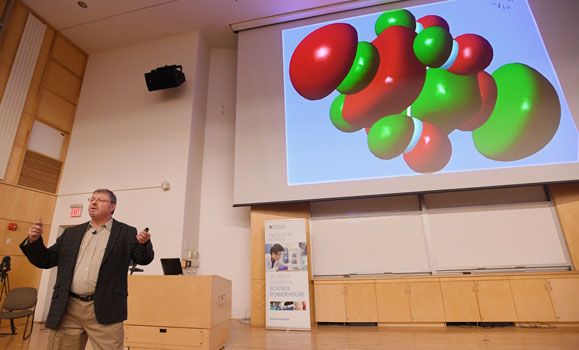Is there a connection between music and quantum physics?
That topic provided the focus of a recent campus lecture by Professor Emeritus Axel Becke, 2016 Canada Council Killam Prize recipient.
Dr. Becke‚Äôs talk, held on November 22, was part of the Dorothy J. Killam Memorial Lecture Series. These lectures are a popular annual event, bringing together the university community, the general public and renowned scholars and thinkers from around the world. This was the ninth time ĻŻĹī ”∆Ķ has hosted the event.
Notes, chords, and symphonies
All matter in our everyday lives ‚Äď everything we touch and see, and what we ourselves are made of ‚Äď consists of electrons moving in the fields of atomic nuclei. The theory that governs the motions of electrons is called quantum theory.
With that in mind, Dr. Becke used musical analogies to help explain the fundamentals of the theory.
The motions of electrons and of guitar strings are both limited to distinct ‚Äúharmonics‚ÄĚ. Just as guitar strings vibrate in certain ways to produce particular sounds, electrons also oscillate in wave-like patterns corresponding to particular frequencies and energy levels. The many electrons in an atom, molecule, or material, occupy these energy levels in pairs having opposite ‚Äď clockwise and counterclockwise¬†‚Äďinternal spins.
It gets complicated, however, when collisions between the electrons are taken into account. Computations of the energetic properties of matter must include this electron ‚Äúcorrelation‚ÄĚ in order to have useful predictive power. A branch of quantum theory called "density-functional" theory (DFT) can handle electron correlation in an elegant and simple manner even in systems ‚Äď such as materials ‚Äď containing countless electrons, and is the foundation of most electronic structure computations today.
Dr. Becke’s groundbreaking chemical theories and computational advances are credited with taking the DFT of electronic motions in atoms, molecules and solids and turning it into an accurate and practical modeling tool for chemical reactions.

Serendipity and science
‚ÄúScience is a human activity,‚ÄĚ says Becke. ‚ÄúSometimes it is being in the right place, at the right time, with the right person.‚ÄĚ
In 1991, Dr. Becke was in Menton, France at the International Congress on Quantum Chemistry. While there, he introduced himself to John Pople, who is considered the ‚Äúgrandfather‚ÄĚ of computational chemistry and co-recipient of the Nobel Prize with Walter Kohn in 1998. The result was a three hour (and five course) lunch, where the two discussed DFT.
‚ÄúHe must have taken home a few things from our conversation, because within a year, he had published a paper on the B88 exchange energy density functional, and came out with a special release of the Gaussian program that included DFT,‚ÄĚ says Dr. Becke. ‚ÄúThis had never happened before, and has not happened since. At that point, every chemist could do DFT calculations.‚ÄĚ
This was the breakthrough moment for DFT in the field of chemistry. Physics and materials science followed suit a few years later.
‚ÄúI don‚Äôt know what would have happened if we did not have that conversation,‚ÄĚ says Dr. Becke.
Today, Dr. Becke’s formulas and calculations are used in everything from drug discovery to cleaner energy, and Dr. Becke is one of the most cited researchers in the world, with more than 100,000 citations to his name so far. According to the journal Nature [2014], two of his articles rank among the top 25 most-cited papers of all time, across all scientific disciplines.
Making global waves in computational science
In addition to being one of the most cited scientists in the world, Dr. Becke’s resume is full of impressive honours. In addition to his 2016 Killam Prize in Natural Sciences, he is:
- A Fellow of the Royal Society of Canada (2000) and the Royal Society of London (2006)
- A medalist of the International Academy of Quantum Molecular Science (1991) and the World Association of Theoretical and Computational Chemists (2000)
- A recipient of the Noranda Lecture Award of the Canadian Society for Chemistry (1994)
- A Canada Council Killam Research Fellow (2005-2007)
- A recipient of the John Polanyi Award of the Canadian Society for Chemistry (2009)
- A recipient of the Theoretical Chemistry Award of the American Chemical Society (2014)
- The winner of the NSERC Gerhard Herzberg Canada Gold Medal for Science and Engineering (2015)
- The recipient of the 2015 Medal of the Chemical Institute of Canada.
Becke has also held the Killam Chair in Computational Science at ĻŻĹī ”∆Ķ from 2006 until his retirement from teaching in 2015. He is now engaged in full-time research.
‚ÄúĻŻĹī ”∆Ķ is the place where it all started,‚ÄĚ says Dr. Becke. ‚ÄúI continue to use those ideas today that I have generated here 35 years ago.‚ÄĚ

